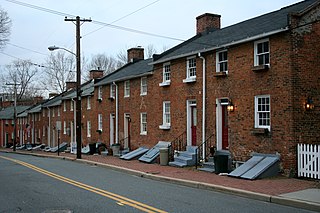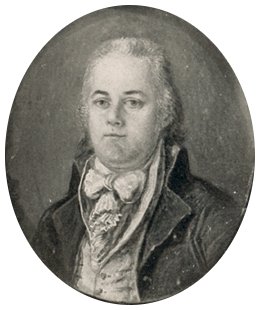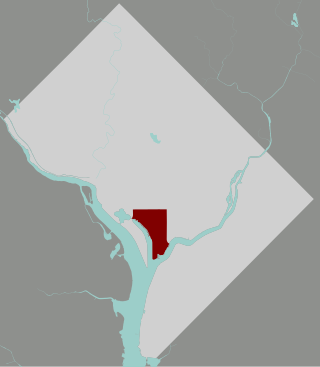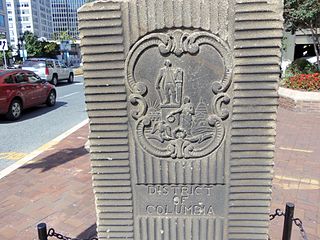
Benjamin Banneker was an African-American naturalist, mathematician, astronomer and almanac author. A landowner, he also worked as a surveyor and farmer.

L'Enfant Plaza is a complex of four commercial buildings grouped around a large plaza in the Southwest section of Washington, D.C., United States. Immediately below the plaza and the buildings is La Promenade shopping mall.

The history of Washington, D.C., is tied to its role as the capital of the United States. The site of the District of Columbia along the Potomac River was first selected by President George Washington. The city came under attack during the War of 1812 in an episode known as the Burning of Washington. Upon the government's return to the capital, it had to manage the reconstruction of numerous public buildings, including the White House and the United States Capitol. The McMillan Plan of 1901 helped restore and beautify the downtown core area, including establishing the National Mall, along with numerous monuments and museums.

Oella is a mill town on the Patapsco River in western Baltimore County, Maryland, United States, located between Catonsville and Ellicott City. It is a 19th-century village of millworkers' homes.

Andrew Ellicott was an American land surveyor who helped map many of the territories west of the Appalachians, surveyed the boundaries of the District of Columbia, continued and completed Pierre (Peter) Charles L'Enfant's work on the plan for Washington, D.C., and served as a teacher in survey methods for Meriwether Lewis.

Ellicott's Stone, also known as the Ellicott Stone, is a boundary marker in northern Mobile County, Alabama. It was placed on April 10, 1799, by a joint U.S.-Spanish survey party headed by Andrew Ellicott. It was designated by the American Society of Civil Engineers as a Historic Civil Engineering Landmark in 1968 and was added to the National Register of Historic Places on April 11, 1973.

Buildings, sites, districts, and objects in Virginia listed on the National Register of Historic Places:

Jefferson Pier, Jefferson Stone, or the Jefferson Pier Stone, in Washington, D.C., marks the second prime meridian of the United States even though it was never officially recognized, either by presidential proclamation or by a resolution or act of Congress.

Silvio A. Bedini was an American historian, specialising in early scientific instruments. He was Historian Emeritus of the Smithsonian Institution, where he served on the professional staff for twenty-five years, retiring in 1987.

The Southwest Waterfront is a neighborhood in Southwest Washington, D.C. The Southwest quadrant is the smallest of Washington's four quadrants, and the Southwest Waterfront is one of only two residential neighborhoods in the quadrant; the other is Bellevue, which, being east of the Anacostia River, is frequently, if mistakenly, regarded as being in Southeast

The boundary markers of the original District of Columbia are the 40 milestones that marked the four lines forming the boundaries between the states of Maryland and Virginia and the square of 100 square miles (259 km2) of federal territory that became the District of Columbia in 1801. Working under the supervision of three commissioners that President George Washington had appointed in 1790 in accordance with the federal Residence Act, a surveying team led by Major Andrew Ellicott placed these markers in 1791 and 1792. Among Ellicott's assistants were his brothers Joseph and Benjamin Ellicott, Isaac Roberdeau, George Fenwick, Isaac Briggs and an African American astronomer, Benjamin Banneker.

Benjamin Ellicott was a surveyor, a county judge and a member of the United States House of Representatives from the State of New York.

Mount Gilboa Chapel is a historic African Methodist Episcopal Church located in Oella, Maryland, United States. It is a small stone church measuring 28 feet by 42 feet, built about 1859 by free African Americans. The front façade is ashlar masonry, but the sides and rear are of rubble.

The Washington Family by Edward Savage is a life-sized group portrait of the Washington family, including U.S. President George Washington, First Lady Martha Washington, two of her grandchildren and a black servant, most likely an enslaved man whose identity was not recorded. The National Gallery of Art in Washington, D.C., presently displays the large painting.

The Garden Club of America Entrance Markers in Washington, D.C., are carven stone pylons installed along the border of the District of Columbia in 1932 and 1933 by local Garden Club of America chapters. Originally about five feet tall, the markers were placed at important entrance points to the national capital. Seven survive: sets of two markers in Westmoreland Circle, Friendship Heights, and Chevy Chase Circle; and a single marker along Georgia Avenue. These surviving markers are listed on the National Register of Historic Places.
According to accounts that began to appear during the 1960s or earlier, a substantial mythology has exaggerated the accomplishments of Benjamin Banneker (1731–1806), an African-American naturalist, mathematician, astronomer and almanac author who also worked as a surveyor and farmer.

Martha Ellicott Tyson was an Elder of the Quaker Meeting in Baltimore, an anti-slavery and women's rights advocate, historian, and a co-founder of Swarthmore College. She was married to Nathan Tyson, a merchant whose father was the emancipator and abolitionist Elisha Tyson. She was the great-great grandmother of Maryland state senator James A. Clark Jr. (1918–2006). She was inducted into the Maryland Women's Hall of Fame in 1988.
George Ellicott (1760–1832) was a son of Andrew Ellicott, who with his two brothers founded Ellicott's Mills, Maryland. He was a mathematician, an amateur astronomer, a younger cousin of surveyor Major Andrew Ellicott and a friend of Benjamin Banneker. He was the father of Martha Ellicott Tyson, who became an Elder of the Quaker Meeting in Baltimore, an anti-slavery and women's rights advocate, the author of a biography of Benjamin Banneker, a founder of Swarthmore College and an inductee to the Maryland Women's Hall of Fame.
A United States postage stamp and the names of a number of recreational and cultural facilities, schools, streets and other facilities and institutions throughout the United States have commemorated Benjamin Banneker's documented and mythical accomplishments throughout the years since he lived (1731–1806). Among such memorializations of this free African American almanac author, surveyor, landowner and farmer who had knowledge of mathematics, astronomy and natural history was a biographical verse that Rita Dove, a future Poet Laureate of the United States, wrote in 1983 while on the faculty of Arizona State University.




















